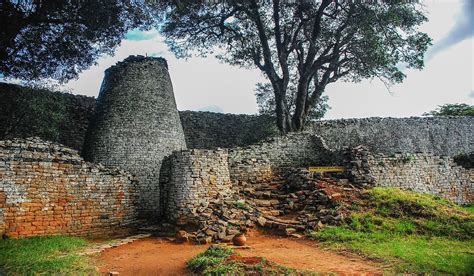The Great Zimbabwe is a remarkable archaeological site located in the southeastern hills of Zimbabwe, near Lake Mutirikwe and the town of Masvingo. It was the capital of the Kingdom of Zimbabwe during the country’s Late Iron Age and flourished between the 11th and 15th centuries. The site is renowned for its impressive stone structures, which include the Great Enclosure and the Conical Tower. These structures were constructed without mortar, showcasing advanced architectural skills and a high degree of social organization. The ruins cover an area of about 7.22 square kilometers and are considered a symbol of African pride and heritage, reflecting the wealth and power of the Kingdom of Zimbabwe at its height.
History and Significance
The history of Great Zimbabwe dates back to the 11th century when it became a major trading center. The city was strategically located to control trade routes and resources, including gold, which was abundant in the region. Its significance is highlighted by its inclusion in various historical records and its influence on regional trade networks that extended as far as China and Persia. The city’s peak period was between the 12th and 15th centuries, after which it gradually declined, possibly due to overpopulation, depletion of resources, and shifting trade routes.

Architecture and Construction
Great Zimbabwe is famed for its dry-stone architecture, where stone walls were constructed without the use of mortar. The most prominent structure, the Great Enclosure, features walls over five meters high and an inner passageway leading to the Conical Tower. This tower, standing about 11 meters tall, is thought to have had a religious or symbolic function. The walls were meticulously built using granite blocks that were carefully shaped and placed to create stable and enduring structures. The construction techniques demonstrate a high level of engineering knowledge and craftsmanship.
Cultural and Economic Life
The inhabitants of Great Zimbabwe were skilled artisans, farmers, and traders. They engaged in farming, animal husbandry, and mining, with gold mining being particularly significant. The economy was bolstered by trade in gold, ivory, and copper, with artifacts from as far away as China and Persia discovered at the site, indicating extensive trade networks. The social structure was complex, with a ruling elite that likely lived within the more fortified and grand sections of the city, while the general populace resided in the surrounding areas.
Decline and Abandonment
The decline of Great Zimbabwe began in the late 15th century. Several factors contributed to its abandonment, including environmental changes, resource depletion, and the shifting of trade routes. Overpopulation might have led to soil degradation and the exhaustion of nearby resources, making the site less sustainable. Additionally, political shifts and the rise of other powerful states in the region may have diverted trade and influence away from Great Zimbabwe, leading to its gradual decline.
Rediscovery and Archaeological Research
Great Zimbabwe was first encountered by European explorers in the late 19th century. The site sparked considerable interest and led to various theories about its origins. Early archaeological investigations were influenced by racial biases, with some attributing the site to non-African builders. However, subsequent research has firmly established that Great Zimbabwe was constructed by indigenous African people. Modern archaeological methods have provided a clearer understanding of the site’s history, construction techniques, and the life of its inhabitants.
Vote
Who is your all-time favorite president?
Modern Importance and Conservation
Today, Great Zimbabwe is a UNESCO World Heritage Site, recognized for its cultural and historical significance. It is a source of national pride for Zimbabwe and a symbol of the rich cultural heritage of Africa. Efforts are ongoing to preserve the site and protect it from environmental and human-induced damage. Conservation programs focus on maintaining the structural integrity of the ruins and promoting sustainable tourism. The site attracts researchers, historians, and tourists from around the world, contributing to the local economy and global understanding of African history.
Influence on Zimbabwean Identity
Great Zimbabwe has had a profound impact on the national identity of Zimbabwe. The country’s name itself is derived from the site, emphasizing its historical and cultural importance. The ruins are depicted on the national currency and featured in various national symbols, reinforcing their role as a cornerstone of Zimbabwean heritage. The story of Great Zimbabwe serves as a reminder of the region’s historical greatness and its contributions to the broader narrative of human civilization.
Educational and Tourism Potential
Great Zimbabwe offers immense educational and tourism potential. It provides a tangible link to the past, offering insights into the social, economic, and architectural achievements of its builders. Educational programs and guided tours help to disseminate knowledge about the site’s history and significance. Tourism development around Great Zimbabwe has the potential to create jobs and support local communities, provided it is managed sustainably to protect the site from overexploitation and degradation.
Advertisement
Challenges and Future Prospects
Despite its importance, Great Zimbabwe faces several challenges. Environmental factors, such as erosion and weathering, threaten the structural stability of the ruins. Additionally, human activities, including tourism and local development, pose risks to the site’s preservation. Addressing these challenges requires coordinated efforts between government bodies, conservationists, and local communities. Future prospects for Great Zimbabwe include the potential for enhanced conservation techniques, increased international collaboration, and the promotion of the site as a global heritage landmark.
Summary
The Great Zimbabwe stands as a testament to the ingenuity and resilience of the people who built and inhabited it. Its impressive architecture, rich history, and cultural significance continue to inspire pride and fascination. Through dedicated conservation efforts and sustainable tourism practices, this iconic site can be preserved for future generations to explore and appreciate.